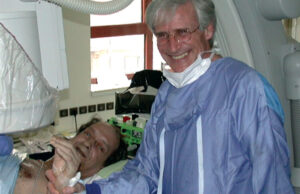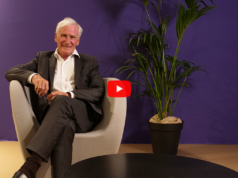
Alain Cribier, the pioneering cardiologist who performed the world’s first transcatheter aortic valve implantation (TAVI) in 2002, has died at the age of 79.
Cribier, who had been the director of cardiology at Charles Nicolle Hospital, University of Rouen (Rouen, France), was recognised globally for his role in advancing the treatment of aortic disease.
Figures from across the world of cardiology have paid tribute to Cribier, who has been described as “a true visionary” whose life and work “stand as a testimony to all that is good in medicine”.
Born in Paris in 1945, Cribier was educated at the University of Paris where he opted to specialise in cardiology. “As far as I remember, my wish has always been to become a doctor,” Cribier told Cardiovascular News in 2003, recalling that his choice of career was influenced by “outstanding physicians who dedicated their whole life to the care of other people”, particularly the writings of AJ Cronin, Georges Duhamel and Albert Schweitzer.
From the archive: Alain Cribier’s 2003 Cardiovascular News profile interview
During his early career, Cribier had the choice to specialise in cardiology or cardiac surgery, ultimately choosing the former thanks to his first experience of cardiac catheterisation in the early 1970s at Hospital Tenon in Paris. “I felt this sub-specialty opened a dramatic and exciting new world of clinical investigation,” Cribier recounted.
In 1976–1977, Cribier spent a year at Cedars Sinai Hospital, Los Angeles (USA), and in 1983, after a fellowship in Los Angeles, Cribier was promoted to the position of professor of medicine and director of the cath lab at Charles Nicolle Hospital, University of Rouen.
It was in Rouen in 1986 that Cribier performed the first of several pioneering procedures, the first cases of balloon valvuloplasty for calcific aortic stenosis, which were reported in The Lancet. This brought Cribier international standing, but he claimed that the limitation of the technique—a high mid-term restenosis rate—pushed him to start a new research programme on a percutaneous heart valve in the 1990s.
“I thought, ‘If there is valvular restenosis, can we do something to maintain the valve open after balloon valvuloplasty?’ Then came the idea of using a mechanical device to prevent valvular restenosis after balloon valvuloplasty. The problem was to find the right device,” Cribier said.
Working with, among others, Marty Leon in the USA, Cribier helped to establish Percutaneous Valve Technologies, a start-up dedicated to the development and commercialisation of the percutaneous aortic valve replacement technology.

It was through this work Cribier cemented his enduring reputation, when, on 16 April 2002, he performed the first-in-man TAVI procedure to huge interest worldwide. The patient, a 57-year-old man, was referred to Rouen having been turned down for surgery due to developing cardiogenic shock. Cribier and his team felt that the percutaneous technique that they had helped to develop could be the only possible solution, which, with the backing of the patient, they deployed using a transseptal antegrade approach.
“The feeling during the first case was great,” Cribier later recounted. “The patient resuscitated on the table. Before that, he was practically dead; he had had several episodes of cardiac arrest before entering the cath lab. Immediately after the valve was implanted, the colour came back to his face, and he was speaking. We could observe a true resuscitation!”
More TAVI cases followed, and thanks to Cribier’s early success, Percutaneous Valve Technologies was acquired by Edwards Lifesciences in 2003, paving the way for the exceptional growth and development of TAVI in the subsequent decades.
“My goal was to try to bring a lifesaving solution to patients who were considered non-operable,” Cribier told Cardiovascular News in 2022, reflecting upon the evolution of the technique following the 20th anniversary of the first procedure. “The story with all the scientific evidence of TAVI against surgery in non-operable patients first, high-risk patients, intermediate-risk patients, low-risk patients, and today we are in a period where [for] older patients, first of all we think about TAVI for them, and surgery in case TAVI cannot be done. It is a totally different paradigm of treatment. This was not expected when I did the first patient at all.”
Among his other achievements in a storied career, Cribier had served as a president of the French Society of Interventional Cardiology and was a co-founder of the Indo-French Foundation for Interventional Cardiology. In 2022, Cribier was awarded the Presidential Citation from the American College of Cardiology (ACC) for his contribution to the development of TAVI. He was also elected an honorary member of France’s National Academy of Medicine and a Knight of the Legion of Honor.
“A true visionary has passed,” said ACC president B Hadley Wilson. “From the first days of balloon aortic valvuloplasty nearly 40 years ago, through the first-in-man TAVI 20 years ago, until today where TAVI is now the standard of care, Dr Cribier always remained humble and committed to his colleagues and the betterment of patient care. The field of cardiology is forever changed because of his vision, leadership and persistence.”
Franz Weidinger, president of the European Society of Cardiology, said: “The passing of Alain Cribier is very sad news. He was a giant in his field and combined his great expertise with a touching kindness and modesty. The European Society of Cardiology and the global cardiology community lose a friend, scientist, clinician, mentor and above all an outstanding personality. Our thoughts and prayers are with his family and loved ones.”












Rest in peace Dr Cribier !
Tes amis du Quebec et des Etats Unis
Danielle Duval NP Cardiology
Lowell Gerber MD Cardiologist